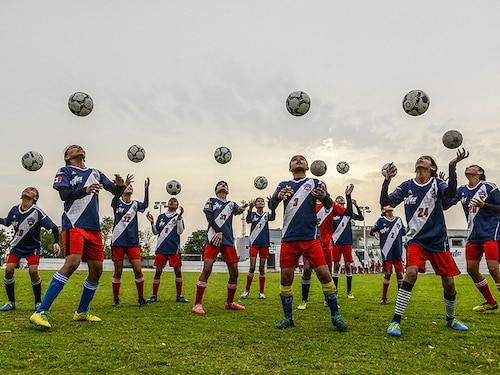Peer pressure as a positive reinforcement tool
Our adolescent and youth population is our critical asset, and their potential economic gains through a 'demographic dividend' can only be realised if our adolescents are healthy


Adolescence is one of the most critical periods in human development. One’s health during the teenage years determines health in the future. Risky behaviours and negligence in youth can have long-term consequences. Nearly two-thirds of premature deaths and one-third of the total disease burden in adulthood are associated with conditions or behaviours initiated in youth. Adolescence is, hence, a crucial phase for inculcating the appropriate health behaviour and attitudes. It could have large, long-term positive impacts.
Just how healthy are our adolescents?
India is home to 253 million adolescents (between the ages of 10-19). A majority of them (181 million) live in the rural parts of the country. Unfortunately, currently Indian rural youth are experiencing a variety of health problems that will most certainly affect not only their productivity but the future of our country as well. Through our experience of running an adolescent health care program in rural India (reaching over 25,000 adolescents) we have observed numerous health challenges. This includes, widespread ignorance about menstruation and menstrual hygiene among girls and the next-to-nil awareness of sexual and reproductive health are leading to high-risk sexual behaviours at a very young age. Nutritional disorders such as anemia have been observed in over 60 percent adolescents, especially girls. Tobacco, alcohol and other substance use are widely prevalent in the young population. Over the past few years, we have also noted a remarkable rise in obesity due to poor dietary habits, stress and mental health issues. What’s even more troubling is that these multiple behaviours and conditions often coexist in the same individual, adding a cumulative risk to their poor health into adulthood. Taking cognisance of this alarming rise in health issues among adolescents, the central government developed a National Youth Policy (2014) highlighting the importance of empowering our adolescents to reach their full potential. Subsequently, a comprehensive national adolescent health programme—Rashtriya Kishor Swasthya Karyakram (RKSK)—was launched to improve the continuum of care for adolescent health and developmental needs.
The power of peers
It is not an easy job inculcating proper health behaviours in a 250 million-plus adolescent population, especially when they prefer to spend more time with their peers and there the influence of peers often supersedes advice or awareness coming from elsewhere. Critical habits and behaviours are formed during this phase largely in imitation of peers. Lack of awareness is the underlying root cause of these myriad health issues. One of the most important sources of information for adolescents, with regards to age-related concerns, is their peers. Thus, harnessing the power of peers through peer education has proven to be an effective health promotion strategy in creating awareness, changing attitudes and beliefs, and empowering the youth to live healthier lives. In fact, various studies have indicated it to be more effective than traditional methods, especially when dealing with sensitive subjects like sexual relationships and substance abuse. By building a strong peer relationship with the youth, peer educators can provide the very critical psycho-social support that the youth so desperately need—discussing concerns they consider a taboo to discuss with family and teachers.
Making peer education an effective strategy
Recognising the importance of peer education, the government, as well as several large NGOs, have now adopted it as a crucial element of their health interventions targeting the adolescent youth. The government's RSKS program uses trained peer educators called Saathiya, who work closely with ASHA health workers and the Village Health Sanitation and Nutrition Committees (VHSNC). There are different peer education strategies that work in both formal and informal settings. Our experiences from the field suggest that informal, interactive strategies such as observing marker days (World Tobacco Free Day), competitions, and games work very effectively because they hold great appeal for the adolescents. These informal strategies, when coupled with the more formal strategies such as awareness sessions by doctors and follow up sessions by the peer educators, add depth to the program, greatly enhancing its impact. Peer education works better when it is delivered through the school system. However, a large number of adolescents, especially girls, drop out of the school system at an early age and thus reaching this group becomes crucial. This bunch can be reached very effectively through WhatsApp groups and the other village level health functionaries. To ensure the sustainability of the program, it is important we link it with the public health system and the RSKS program wherever it is currently functional. At the heart of the peer education program is the appropriate identification and selection of peer educators and the depth of training provided to them. There are certain universal qualifications and requirements for peer educators. They should have a socio-cultural background similar to target audiences and be respected by them. Equally essential qualities are a non-judgmental attitude towards others, self-confidence and leadership potential. Most importantly, they need to be positive and healthy role models themselves. The training provided to peer educators is the other crucial element of a successful program. A variety of skills need to be provided: communication skills such as active listening, and exhibiting empathy are important. For peer educators to be effective and motivated, the training needs to be continuously reinforced.
In conclusion
We need to recognise that our adolescent and youth population is our critical asset. They are the creators and leaders of the future. But they can shape the future of the country only if they are in good health. We need to collectively invest in these assets, by inculcating the right health behaviours at an early age. The potential economic gains through a 'demographic dividend' can only be realised if our adolescents are healthy. The writer is a CEO of Ambuja Cement Foundation
First Published: Feb 15, 2021, 18:14
Subscribe Now